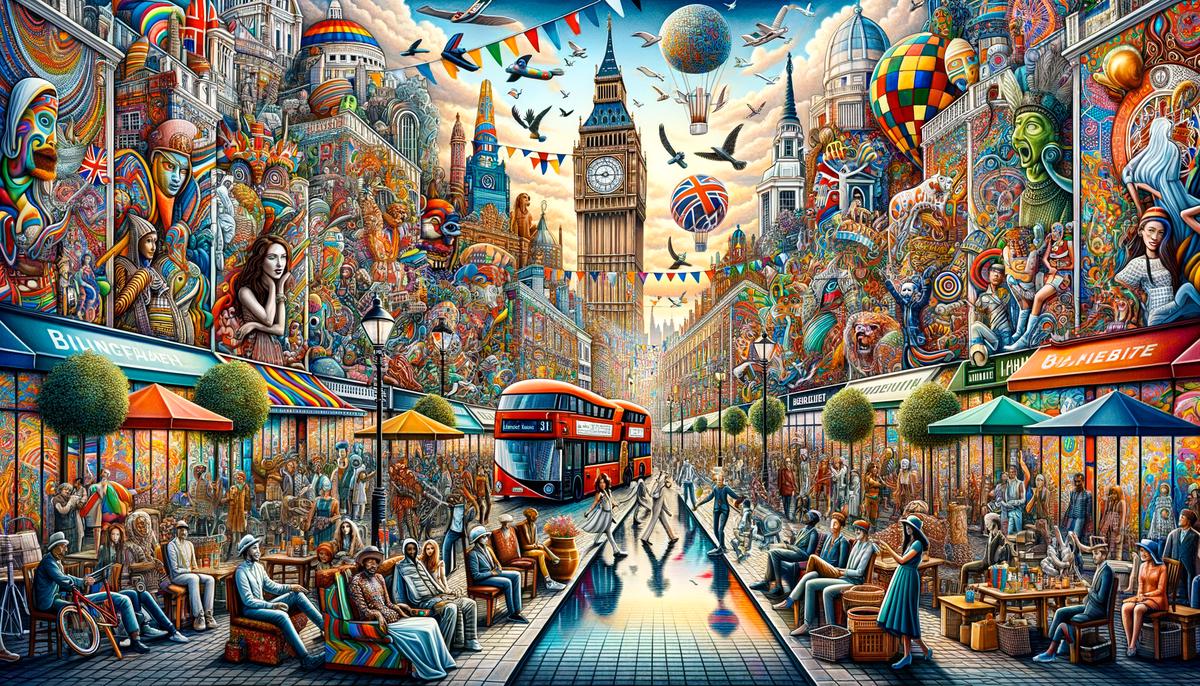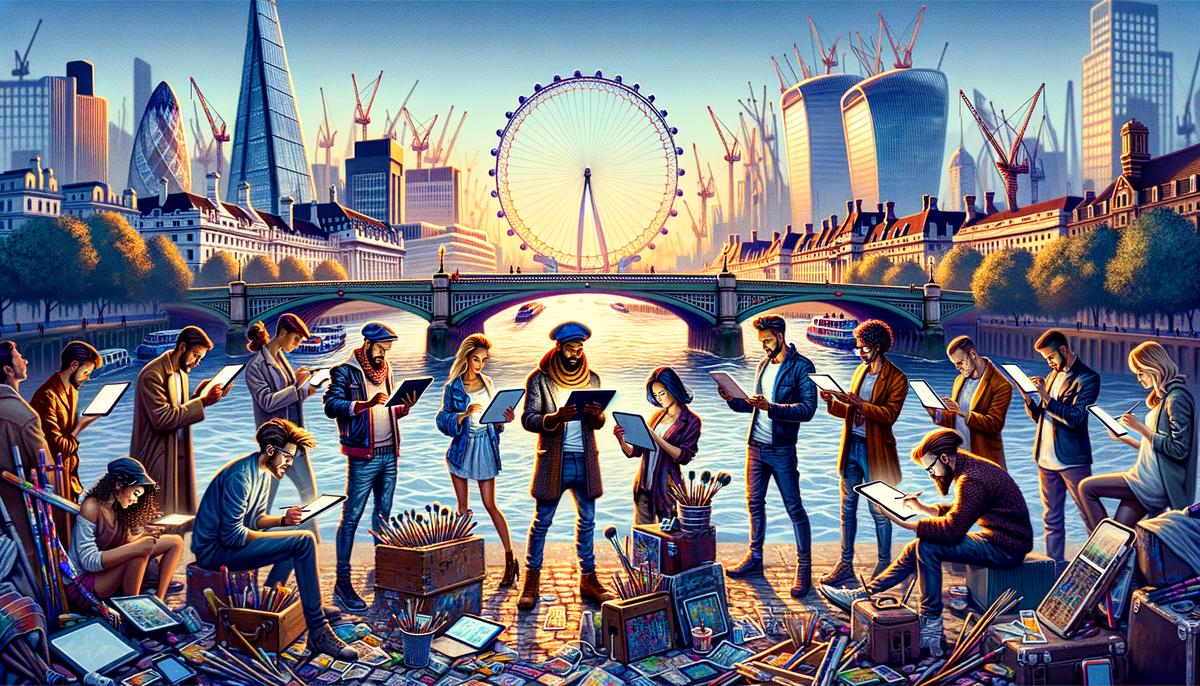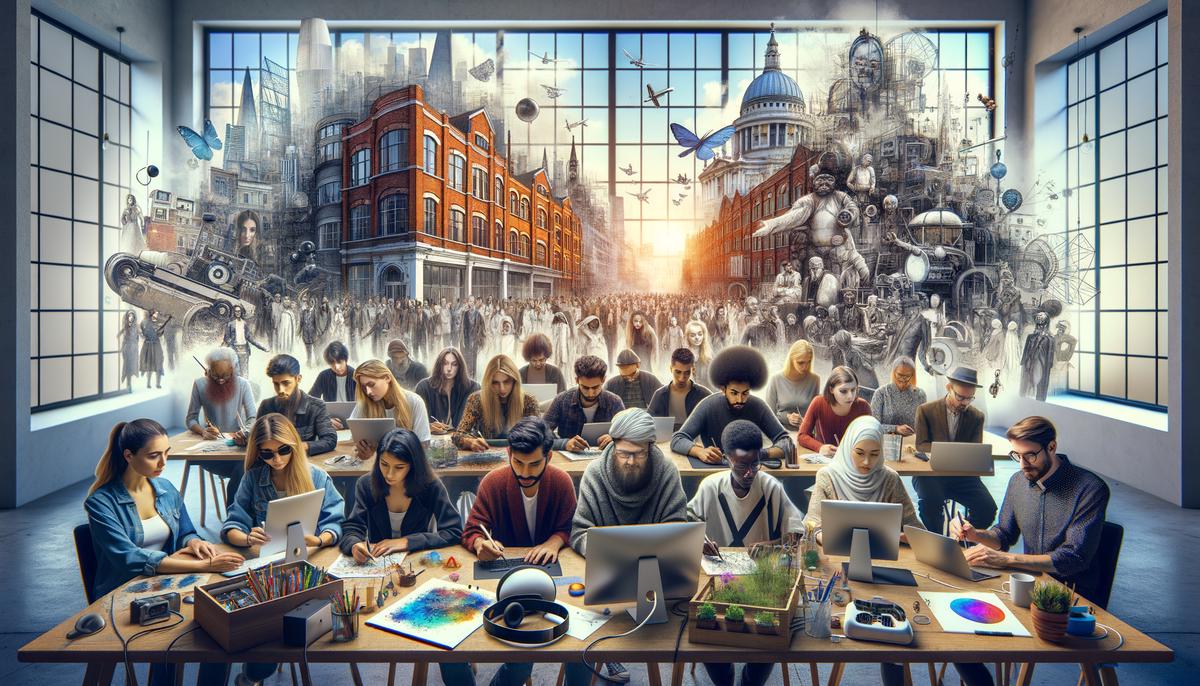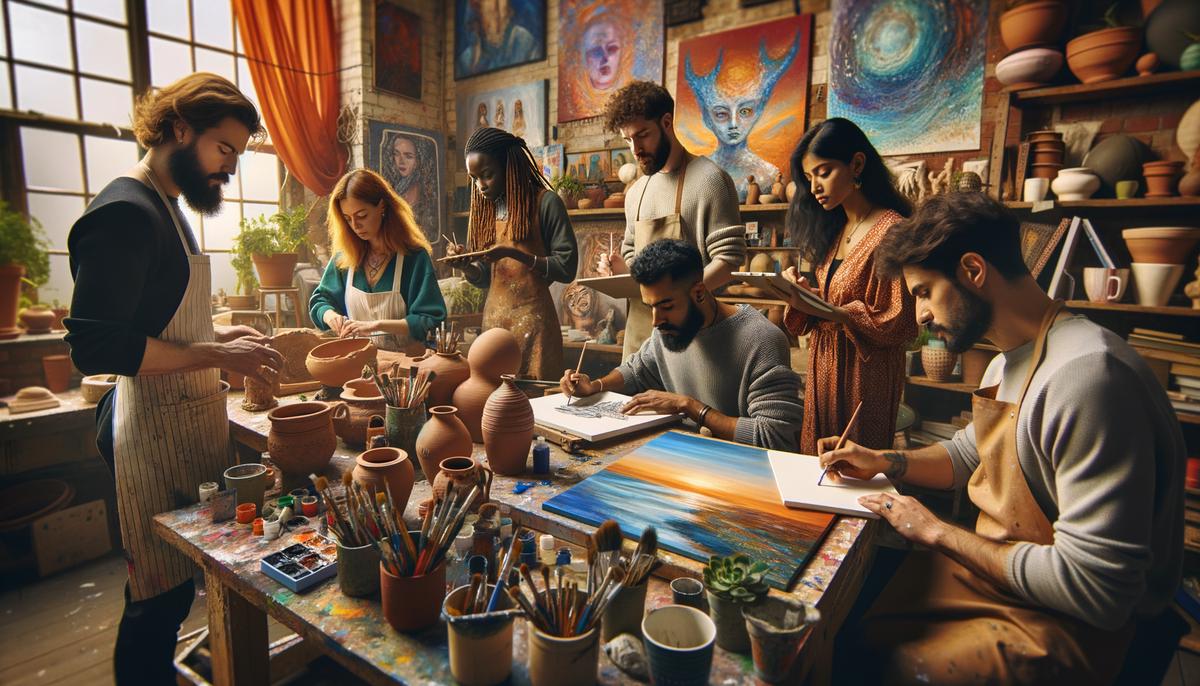London’s art scene is a vibrant showcase of diversity, reflecting the city’s multicolored cultural fabric through its various expressions and mediums. This article explores how the blending of cultures and digital innovation molds the contemporary artistic landscape, revealing a dynamic interplay that shapes the identity and experiences of both emerging and established artists in the city. The exploration includes the impact of digital platforms, the economic and creative challenges faced by artists, and the power of community in fostering a collaborative and innovative art scene.
The Cultural Tapestry of London’s Art Scene
London stands as a majestic tapestry woven from the threads of varying cultures, each strand representing a unique story, belief, or tradition. This rich cultural diversity doesn’t just color the city’s neighborhoods or its culinary panorama but seeps into the very core of its emerging art scene. The streets, galleries, and hidden corners of London whisper tales not merely of British history but of a global confluence, shaping a contemporary art landscape that is as varied as the populace that dapples its streets.
Diving into the heart of London’s art scene reveals a vibrant blend of traditional British artistry entwined with the fresh, innovative perspectives brought in by immigrant communities and international influences. The city, a proud host to people from all corners of the globe, mirrors this multiculturalism in its artistic expressions, ranging from graffiti in Shoreditch to avant-garde installations in the Tate Modern. This is not merely a coincidence but a testament to how London’s diverse culture acts as a crucible for artistic innovation.
The streets of Brixton, for example, echo with the rhythms of Caribbean music, which in turn inspire vibrant murals that adorn the neighborhood, telling stories of migration, struggle, and triumph. These pieces are not just decorations but narratives, weaving the fabric of communal identity and providing a visual lexicon that speaks to the shared experiences of its diverse populace.
Similarly, the influence of London’s sizable South Asian community can be seen in the explosion of colors in festivals and events such as Diwali and Holi, which have found their echo in the bold, expressive works of British-Indian artists. These festivals, celebrating light and color, serve as muses for artists, infusing London’s art scene with motifs and themes that reflect a rich heritage and blending them with contemporary realities to create something entirely new.
In East London, a cauldron of creativity, galleries and pop-up exhibits showcase works that blur the boundaries between traditional European art forms and innovative approaches drawn from across the globe. Here, one can witness the dialogue between the old and the new, the east and the west, articulated through art. It’s a place where an installation might juxtapose the quiet minimalism of Japanese aesthetics against the backdrop of London’s industrial vigor, creating a narrative that speaks to a cosmopolitan audience.
Furthermore, the digital age has accelerated this cross-pollination of ideas, allowing London-based artists to draw inspiration from global movements almost instantaneously. The city’s art institutions, recognizing the value in this diversity, have embraced more inclusive programming that reflects London’s multicultural identity. They act as platforms where artists of various backgrounds can exhibit their works, fostering an environment where conversations about identity, heritage, and belonging are encouraged and explored through artistic expression.
The fusion of cultures in London has thus given rise to an art scene that is dynamic and ever-evolving. Artists, driven by the city’s plurality, continually push the boundaries of traditional art forms, experimenting with new materials, techniques, and concepts that reflect the multiplicity of their experiences and identities. In doing so, they not only contribute to the city’s cultural wealth but also challenge and expand the global artistic discourse.
This synergy between London’s cultural diversity and its art scene exemplifies how the movement of people and the mingling of cultures can act as a catalyst for creative innovation. In London, art does not exist in a vacuum but is a living, breathing reflection of the city’s soul – complex, diverse, and endlessly fascinating. It is in this interplay of influences that London’s emerging art finds its strength, its voice, and its relevance, making the city a beacon for those who seek to understand how diversity shapes and enriches our world.

The Impact of Digital Platforms on Exposure and Success
In the heart of London, a revolution hums within the brick-laden studios and cluttered apartments of emerging artists. It is not a rebellion announced with loud proclamations or clamorous marches, but with the silent, yet profound, shift towards digital platforms. This subtle coup has not only dismantled traditional barriers but has redefined the trajectories of these creative minds in ways both startling and sublime.
Digital platforms, in their ubiquitous and omniscient presence, have emerged as the modern amphitheaters for artists in London, where the milieu is as diverse as the city itself. The virtual world has become a canvas, gallery, and marketplace all rolled into one, offering unprecedented access and opportunities. For the emerging artist, these platforms serve as bridges—ones that connect the secluded studio to the global audience, the solitary creation to the collaborative masterpiece.
One of the most significant transformations wrought by these digital realms is the democratization of exposure. In times past, an artist’s destiny was often tethered to the whims and fancies of gallery owners and art dealers. Today, Instagram, Twitter, and online portfolios serve as windows that open not to a street in London but to the world. An artist in Peckham now competes not just with peers in neighboring Brixton but with contemporaries in New York, Berlin, and Tokyo. This exposure is double-edged, introducing both a broader audience and a wider pool of competition. Yet, it invariably nudges the artist towards innovation and originality, fostering a unique voice that can resonate on a global scale.
Moreover, online platforms are not merely showcases but bustling markets where art is not just seen but sold. The rise of online galleries and auction sites has transformed the economics of art ensuring that an emerging artist in London can sustain their craft not merely as a passionate pursuit but as a viable livelihood. This shift also challenges the artist to become an entrepreneur, mastering not only their medium but also the nuances of digital marketing and online sales. The artist, thus, evolves not into a mere purveyor of visuals but into a savvy businessperson navigating the digital age.
The intersection of art and technology on these platforms has also led to the birth of new art forms. Digital art, NFTs (Non-Fungible Tokens), and virtual reality art are no longer futuristic concepts but present realities. Artists are experimenting with software, coding, and digital canvases to create art that could not have been conceived, let alone realized, in any other era. This confluence of art and technology is not just transforming the types of art being produced but is altering the very fabric of creativity itself.
Furthermore, these digital gateways foster communities unlike any artist collective of the past. Social media groups, forums, and online workshops connect artists in London with their counterparts across the globe. These virtual spaces become incubators for ideas, critiques, support, and collaborations, ignoring geographical boundaries and cultural differences. An artist in London might find their perfect collaborator in Seoul, their mentor in São Paulo, and their biggest supporter in Cairo. This global community not only enriches the artist’s personal and professional growth but contributes to a cross-pollination of styles, techniques, and ideas that continually propels the art world forward.
Yet, amid this digital euphoria, challenges persist. The overwhelming volume of content can sometimes drown individual voices, and the quest for digital validation can sway artists from their true paths. The screen, despite its connective power, can sometimes isolate more than unite, reducing the tangible joy of experiencing art in person. Nevertheless, the trajectory for emerging artists in London, influenced by digital platforms, veers towards a horizon vibrant with possibilities, fraught with challenges, yet infinitely promising. The journey from obscurity to recognition, from creation to collaboration, is now marked not by footsteps but by digital footprints, leading the way into uncharted yet exhilarating landscapes of art and expression.

Sustaining Creativity in Urban Dynamics
In the ever-vibrant city of London, emerging artists face the formidable challenge of sustaining their creativity in a landscape that is as ever-changing as it is stimulating. As the brick-and-mortar world meshes with the expanding digital universe, these creative minds find themselves navigating a terrain that demands not just adaptability and resilience, but a pioneering spirit to harness the new tools and platforms at their disposal.
The rise of digital platforms has undeniably revolutionized the way art is created, shared, and consumed. Instagram, and online portfolios, for instance, have become pivotal for artists looking to showcase their work. These platforms not only break the geographical barriers that once limited an artist’s audience but also democratize the exposure that was traditionally reserved for those with access to mainstream galleries and exhibitions. Through a single post, an artist in London can captivate an audience spanning from the bustling streets of New York City to the quiet, picturesque lanes of Kyoto.
Yet, this ease of access brings its conundrums. The digital realm’s democratization of exposure also means emerging artists are swimming in a sea teeming with content. Standing out requires not just talent but strategic acumen; understanding algorithms and engagement becomes almost as crucial as the brush strokes on a canvas. Moreover, the intimacy and impact of experiencing art in person are challenged by the screen’s isolating barrier, transforming the once palpable reaction into likes and comments.
This new digital age also transforms the economics of art. Online galleries and auction sites are redefining traditional financial models, flipping the script on how artists sell their work and interact with buyers. The virtual marketplace offers an alternative to the conventional art scene, allowing artists to bypass galleries and connect directly with art enthusiasts. However, it necessitates a shift towards entrepreneurial thinking, where artists must not only be creators but savvy business individuals navigating the complexities of online sales and marketing.
The emergence of digital art, NFTs (Non-Fungible Tokens), and virtual reality art represents a frontier of boundless possibilities. These new mediums are not just reshaping the artistic landscape but are redefining what art can be. An NFT, for example, offers something revolutionary: a way for digital art to be one-of-a-kind, collectible, and tradeable, much like traditional art pieces but in the digital sphere. Virtual reality art, on the other hand, invites viewers into immersive worlds, expanding the canvas beyond the physical boundaries of our reality.
The digital age also fosters global communities and collaborations, erasing the once insurmountable distances between creators. London’s emerging artists now have the opportunity to collaborate with peers from across the globe, sharing ideas, cultures, and inspirations that weave into the rich tapestry of the city’s art scene. These collaborations not only enrich the individual artist’s work but contribute to the collective evolution of London’s artistic identity.
Navigating the challenges and embracing the opportunities of the digital age, London’s emerging artists are at the cusp of a new era. While the digital realm presents hurdles such as content saturation and the loss of tangible experiences, it also opens doors to innovative art forms, global audiences, and unprecedented modes of collaboration. In the heart of a city known for its dynamic evolution, these artists are not just surviving; they are thriving, redefining the boundaries of creativity in a world where the digital and physical converge.

Collaborative Movements and the Power of Community
In the labyrinthine streets of London, a revolution quietly brews—not of discontent, but of creativity, fueled by the spirit of collaboration among the city’s emerging artists. This movement, a tapestry woven from the threads of innovation, digital proliferation, and communal endeavor, is not only reshaping the landscape of art in London but also redefining the parameters of success and visibility for the new artist.
Amidst this revolution, the phenomenon of co-working spaces and collectives emerges as a cornerstone. More than just shared studios, these hubs are crucibles of creative synergy, where diverse ideas and cultures intermingle to birth groundbreaking art. They dismantle the stereotypical image of the solitary artist, replacing it with a community-driven model where feedback and collaboration propel artistic growth. In neighborhoods like Hackney and Peckham, these spaces are not merely locales of artistic production but sanctuaries that foster a sense of belonging and mutual support among artists navigating the precarious initial stages of their careers.
Parallel to physical gatherings, the digital realm hosts its own version of collaborative innovation. Online forums and social media platforms have democratized mentorship and critique, allowing artists to connect, share, and collaborate virtually with peers across the globe. These digital communities function as incubators for creativity, where emerging talents find not only inspiration but also practical advice on navigating the complexities of the art world. In this context, platforms like Patreon and Kickstarter play a pivotal role, enabling artists to seek direct support from their audience, thereby circumventing traditional gatekeepers of the art industry.
Furthermore, the rise of interdisciplinary projects marks a significant departure from traditional art-making practices. Today’s London artists are increasingly blurring the lines between visual arts, digital media, performance, and storytelling. Collaborative projects often feature a mélange of mediums, with artists pooling their varied skills to create multisensory experiences that challenge the limits of conventional art forms. These collaborations, reflective of London’s multicultural vibrancy, echo the city’s rich tapestry of identities, narratives, and histories.
Yet, this collaborative ethos is not devoid of challenges. The emphasis on digital platforms and virtual spaces, while opening avenues for exposure, also raises questions about the digital divide and the authenticity of online interactions. Moreover, the commercial pressures of the art market necessitate a delicate balance between artistic integrity and market appeal, urging artists to tread carefully between innovation and commodification.
Despite these hurdles, the spirit of collaboration among London’s emerging artists heralds a promising shift. It signals a move towards an art ecosystem that values diversity, inclusivity, and communal success over individual achievement. As this movement gains momentum, it not only amplifies the voices of emerging artists but also lays the foundation for a more resilient, interconnected, and innovative art community in London.
In essence, the future of London’s art scene rests not on the laurels of its past but on the collective endeavors of its present talents. As these artists join hands—across co-working spaces, digital platforms, and interdisciplinary projects—they weave a vibrant narrative of cooperation and creativity. This narrative, steeped in the spirit of mutual support and shared success, promises to usher in a new era for London’s art, one where collaboration is not just a strategy but the very ethos that shapes the future of art in the metropolis.

As London’s art scene continues to evolve, it stands as a testament to the city’s resilience and capacity for reinvention, driven by a community of artists who are as diverse as the creations they produce. The collaborative spirit, coupled with the embrace of digital platforms, not only promotes a richer, more inclusive art culture but also challenges and expands our understanding of what art can be. This dynamic fusion of tradition and innovation, of individual creativity and collective effort, ensures that London remains at the forefront of the global art scene, inspiring future generations to explore, create, and dream.
























